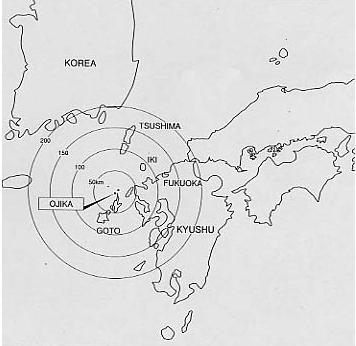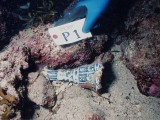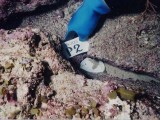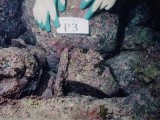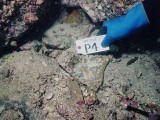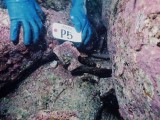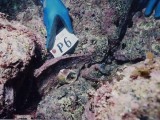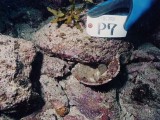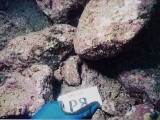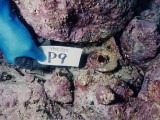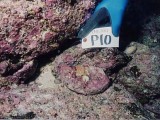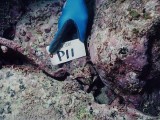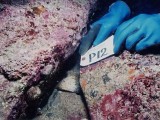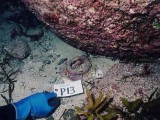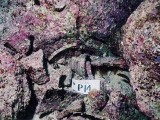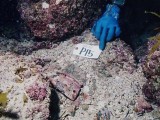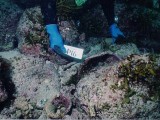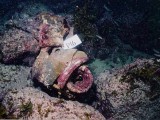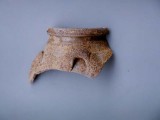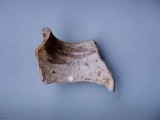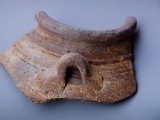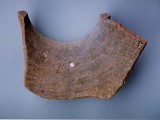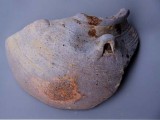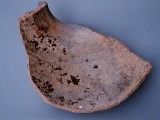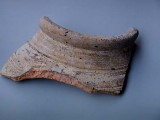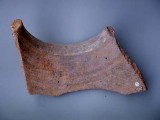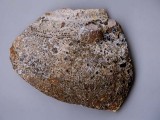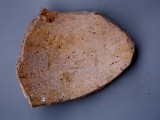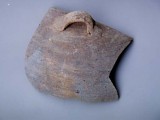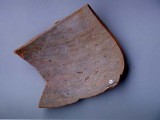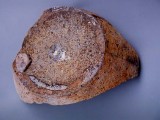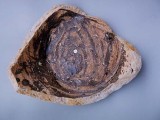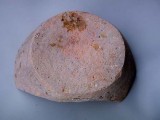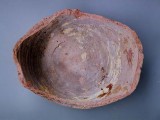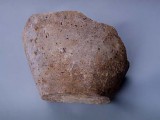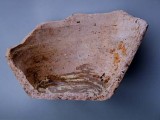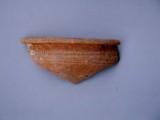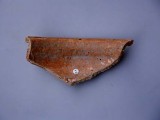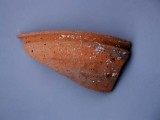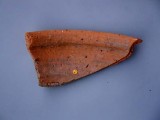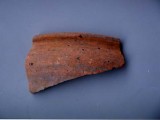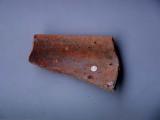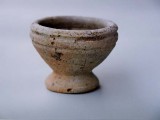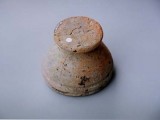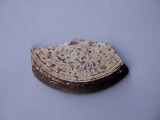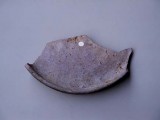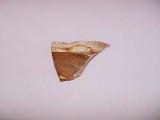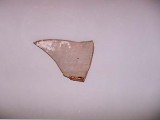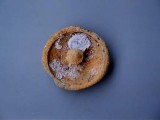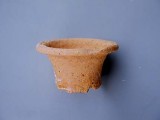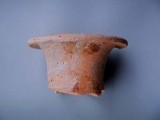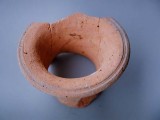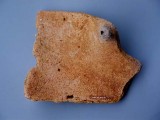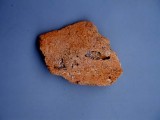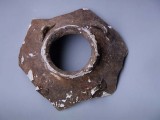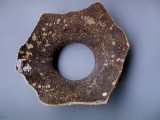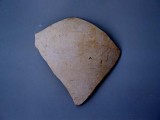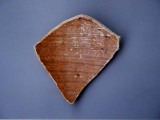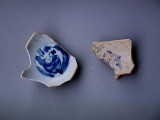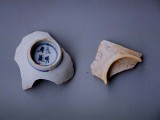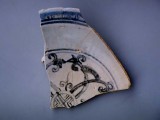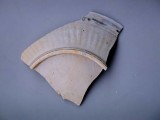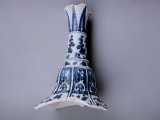Archaeological Report of Ojika-cho Cultural Property XVI
Yamami Underwater Site
-Report of the Archaeological Survey of Yamami Underwater Site-
Ojika-cho, Nagasaki Pref.
by Kyushu and Okinawa Society for Underwater Archaeology
and
Ojika-cho Board of Education
2002
Introduction
Chapter I Outline of the Survey
1. Procedures of the Survey
2. Organization of the Survey
Chapter II Location of Archaeological Sites and Historical Environment
1. Geological and Historical Environments of Archaeological Sites.
2. Yamami Underwater Site
Chapter III Record of the Survey
1. Method of the Survey
2. Retrieved Objects
Chapter IV Conclusion
Introduction
The archaeological survey has been done at the sea of 5 meters in depth and about 100 meters off the coast of Karamizaki, which faced Nozakijima Island (PLs. 1 and 2). Six pottery shards such as Thai earthen jars and stemmed mortars were recovered by a fishery diver (Ama) in 1992, and they were submitted to the board of education. The Ojika-cho board of education showed the concern about these objects and registered the site as “the submerged site off the coast of Yamami”. This archaeological survey was to have clarified the characteristics and range of the Yamami underwater site (Fig. 1).
The site facing Nozakijima Island toward the east is located in the western edge of the strait of about 1.5 kilometers in width where the strong prevailing currents and tidal surge the region. Thai earthenwares, Chinese ceramics, and other wares are distributed to about 30 meters in width and about 80 meters in length and extend towards northeast, and most pottery shards have been discovered in the narrowed space opened between rooks. However, there are very few pottery shards to have been found on the sand, because it is difficult for them to keep in situ under such undersea environment (Figs. 3 and 4, PLs. 4 and 5).
Pottery (Figs. 5-8, Tabs. 1 and 2, PLs. 8-24)
This archaeological survey is primary one; therefore, we did not have any excavations at this site. The purpose of the survey is to understand the characteristics of the site and to know what kinds of pottery shards there are at the site, and to know the distribution of these objects. As to the pottery shards found at the site, we recovered eighty-seven pieces for a sample; seventy-four pieces from Thai are earthenwares and coarse wares, eight pieces from China are four blue white porcelains and four earthenwares, two blue white porcelains as Japanese ceramics belong to Hizen, and three shards are unknown origin, but two of them are might be belonging to Vietnamese earthenware.and coarse ware.
1) Thai earthenwares and coarse wares (Figs. 5-8, PLs. 25-52 and 57-64)
Jars (Nos. 1-17) are unglazed and fine fabric pottery. Most of these jars seem to belong to the jars with four loop handles on the shoulder and relatively large in size; Nos. 1-5 are fragments of the mouth. Nos. 6-10 are fragments of the shoulder or body. Nos. 11-17 are fragments of the base. Complete shape of jar however has not been found at this site. These kinds of jars can be divided in four types based on the shape of the mouth by Tsuzuki’s chronology. The jars found at Yamami closely resemble to the third type or the fourth type. The third type is most likely dated to the third quarter of the sixteenth century. The fourth type is parallel to the jars in the burnt layer found at the site of Sakai moated city, dating the 20th year of Keicho (1615).
Wide mouthed cooking bowls (Nos. 18-31) are unglazed and fine fabric pottery. Most of them are not complete in figure. The shape from the mouth to the body is a figure of S, and the base is flat. The shape of the mouth can be divided into three types; 1) inside of the mouth is carved, and a low terrace on the top of the mouth, 2) no carved mouth with an edge on the top of the mouth, 3) no edge on the top of the mouth.
Stemmed mortars (Nos. 32-33) have the inward mouth and the flat base. They are most likely used for grinding spices. They have been found at the sites of Lopburi and Ayuthya. This type of earthenwares can be seen today in Thailand and called “khrok”.
Lid (No. 34) is fine fabric pottery, and a grip on the top is missing. Three grooves along the edge of the top and five compass circled grooves in the center of the top are running. Lid (No. 36) is coarse ware and used for the cover of the jar.
Jar (No. 37) is coarse ware and a single groove circled on the top of the mouth. Jar (No. 38) is a fragment of the mouth through neck. The fabric is relatively fine, and a single groove circled on the top of the mouth.
Portable kitchen ovens (No. 39 and PLs 63 and 64) are shards of the ovens. Two shards seem to belong the same oven. For No. 39(PL.63), a small project to support the vessel can be seen. PL. 64 is more likely a shard of the base. Similar specimens have been found at the site of Sakai moated city and at the area of the main gate of the Osaka castle.
2) Chinese ceramics and earthenwares (Fig. 8, PLs. 53-56 and 67-71)
Black-glazed jar with four handles on the shoulder (No. 35). Nos. 42-45 are blue white porcelains dating to the second half of the sixteenth century except No.44 belonging to the first half through the mid sixteenth century. No. 42 is a shard of the bowl fired in Jingdezhen. The interior surface of the base is curved outward and painted with a Chinese. The exterior base is painted with Chinese characters “大明年造”. No. 43 belonging to Jingdezhen and was not fired well. The interior base is painted with floral design, and the exterior base is painted with two circle lines in blue. No. 44 is a shard of the dish and fired in Jingdezhen. The mouth is sharply extending outward, and the edge of the mouth is carved in petals. The vertical grooves can be seen on either side of the body. This specimen seems to be older than the other Chinese ceramics. No. 45 is a shard of the vase and fired in Jingdezhen. The both sides are glazed, and the exterior area between the neck and the body is divided into eight canvases with vertically elevated lines. Each canvas is painted with floral design. The area of the neck is horizontally divided into three canvases and painted with banana’s leaf, pine tree, and floral design.
3) Vietnamese earthenware and coarse ware (No. 41, PLs. 57, 58, 65, and 66)
Two of the recovered pottery shards from the site are might be Vietnamese, however, these specimens are too small to identify the shape and the origins of the pottery; No.41 (PLs. 65 and 66) is unknown in shape and coarse ware, and survived shard is half a round in shape. This shard seems to belong to a cover with a knob missing, and the unglazed and fine fabricated lid might be Vietnamese. A similar specimen in shape can be found in the central region of Vietnam. PLs. 57and 58 are the outside and inside of the shard of the jar. This shard is relatively fired well and fine fabric. The interior is smoothed by fingers and purplish brown color. The exterior is brown and covered with yellow graze. Tsuzuki suggests that this shard might belong to earthenware found in Vietnam.
4) Other earthenwares (Tab.2. P5-5)
This pottery is a shard of the jar with four handles and has probably been made in the southern region of China.
5) Japanese ceramics (Figs. 8-46 and47, PLs.72 )
No.46 is a fragment of the vase and painted with bamboo leaf design. This specimen was fired at Hasami, Nagasaki Pref. in nineteenth century. No. 47 belongs to the lid and dating to after the nineteenth century or after. These shards are only two specimens, which are different from the other pottery in date.
Characteristics of the Site (Fig. 2)
The characteristics of the Yamami submerged site could get them from the pottery collected by this archaeological survey; the characteristics of the site and its problems come to the surface, and some interpretation becomes possible about them.
First of all, the area where the pottery have been concentrated is very limited space; it is about 10m in radius. Inside of the area Thai earthenwares, which are most dominated pottery of this site, Chinese blue white porcelains, Vietnamese earthenwares, and other earthenwares have been seen. If the distribution of the pottery scattered within the small area at the bottom of the sea represents the scattered cargos and indicates the site where a ship went down, it is quite strange that objects other than pottery cannot be found. Furthermore, if the ship is allowed to be final rest at this site, the cargos should be found in the very wide range. But why is the distribution of the pottery limited to a small area?
Secondly, Thai earthen jars with four handles carries the contents as a comparatively large container. If it is most likely that these jars were hold at the bottom of a ship to the substitution of the ballast, the amount of the earthen jars found at the bottom is not much. There are sunken ships having been discovered in the seas of Southeast Asia and East Asia; their cargos like pottery or ceramics have played the role of the ballast. Moreover, a large amount of bronze coins was used as the ballast in the sunken vessel found in South Korea.
Thirdly, there are notable objects other than the pottery such as stemmed mortars and portable kitchen ovens are seemed to have been used as utensils in the ship instead of commodities with Chinese blue white porcelains such as dishes, bowls, and jars.
Conclusion
It has not yet come to a conclusion on the Yamami submerged site. A full scale of excavation on this site, however, will resume in the near future. It is possible to understand that Ojikajima Island was under the historical and geographical environment representing a part of economic activity of the sea in East Asia during the early modern age. Archaeological remains and many objects having found on this island indicate that Ojikajima Island was the important place for a foreign exchange in the sea under the historical and geographical background from ancient time to the Middle Ages, and until the early modern time.

